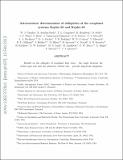ASTEROSEISMIC DETERMINATION OF OBLIQUITIES OF THE EXOPLANET SYSTEMS KEPLER-50 AND KEPLER-65
Author(s)
Chaplin, William J.; Campante, T. L.; Handberg, R.; Stello, D.; Basu, S.; Christensen-Dalsgaard, J.; Davies, Guy R.; Metcalfe, T. S.; Buchhave, Lars A.; Fischer, Debra A.; Bedding, Timothy R.; Cochran, William D.; Elsworth, Y.; Gilliland, Ronald L.; Hekker, Saskia; Huber, Daniel; Isaacson, Howard; Karoff, C.; Kawaler, S. D.; Kjeldsen, H.; Latham, David W.; Lund, Mikkel N.; Lundkvist, M.; Marcy, Geoffrey W.; Miglio, A.; Barclay, Thomas; Lissauer, Jack J.; Sanchis Ojeda, Roberto; Winn, Joshua Nathan; ... Show more Show less
DownloadWinn_Asteroseismic.pdf (2.871Mb)
OPEN_ACCESS_POLICY
Open Access Policy
Creative Commons Attribution-Noncommercial-Share Alike
Terms of use
Metadata
Show full item recordAbstract
Results on the obliquity of exoplanet host stars—the angle between the stellar spin axis and the planetary orbital axis—provide important diagnostic information for theories describing planetary formation. Here we present the first application of asteroseismology to the problem of stellar obliquity determination in systems with transiting planets and Sun-like host stars. We consider two systems observed by the NASA Kepler mission which have multiple transiting small (super-Earth sized) planets: the previously reported Kepler-50 and a new system, Kepler-65, whose planets we validate in this paper. Both stars show rich spectra of solar-like oscillations. From the asteroseismic analysis we find that each host has its rotation axis nearly perpendicular to the line of sight with the sines of the angles constrained at the 1σ level to lie above 0.97 and 0.91, respectively. We use statistical arguments to show that coplanar orbits are favored in both systems, and that the orientations of the planetary orbits and the stellar rotation axis are correlated.
Date issued
2013-03Department
Massachusetts Institute of Technology. Department of Physics; MIT Kavli Institute for Astrophysics and Space ResearchJournal
The Astrophysical Journal
Publisher
IOP Publishing
Citation
Chaplin, W. J., R. Sanchis-Ojeda, T. L. Campante, R. Handberg, D. Stello, J. N. Winn, S. Basu, et al. “ASTEROSEISMIC DETERMINATION OF OBLIQUITIES OF THE EXOPLANET SYSTEMS KEPLER-50 AND KEPLER-65.” The Astrophysical Journal 766, no. 2 (March 14, 2013): 101.
Version: Author's final manuscript
ISSN
0004-637X
1538-4357